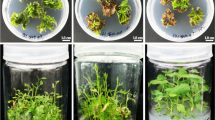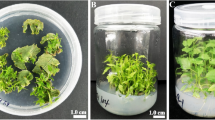Abstract
A total of 120 nodal segments of Chrysanthemum ‘Gongju’ plantlets were treated with colchicine to obtain autopolyploidy. Flow cytometry showed that 1 of the 12 surviving seedlings had DNA contents that were twice that of tetraploid plants. Microscopy revealed that the epidermal cell and stomatal area of octoploid plant leaves were larger than those of tetraploid plant leaves. Morphological characteristics showed that the plant height of octoploid plants did not differ from that of tetraploid plants, but their leaves and flowers remarkably varied. The leaves and flowers of octoploid plants were larger than those of tetraploid plants. The diameters of the inflorescence and disc flower of octoploid plants increased by 7.2% and 28.4% compared with those of tetraploid plants, respectively. Similarly, the numbers of their ligulate and tubular flowers increased by 22.6% and 34.0% compared with those of tetraploid plants, respectively. Semi-lethal temperature (LT50) of tetraploid plants was − 8.58 °C, while LT50 of octoploid plants decreased by 3.4 °C. At low temperatures, the relative expression levels of CmICE, CmDREB, CmCOR, CmPYR1, CmFAD, CmWRI, CmBAM, and CmPSP genes related to cold resistance in octoploid plants were higher than those in tetraploid plants. Conversely, the expression levels of CmAPX and CmGSH in octoploid plants were lower than those in tetraploid plants. The relative expression levels of CmOST, CmPDH, and CmOAT did not differ between octoploid and tetraploid plants.





Similar content being viewed by others
References
Byun MY, Lee J, Cui LH, Kang Y, Oh TK, Park H, Lee H, Kim WT (2015) Constitutive expression of DaCBF7, an Antarctic vascular plant Deschampsia antarctica CBF homolog, resulted in improved cold tolerance in transgenic rice plants. Plant Sci 236:61–74
Cheng W, Tang M, Xie Y, Xu L, Wang Y, Luo X, Fan L, Liu L (2019) Transcriptome-based gene expression profiling of diploid radish (Raphanus sativus L.) and the corresponding autotetraploid. Mol Biol Rep 46:933–945
Chinnusamy V, Zhu J, Zhu JK (2007) Cold stress regulation of gene expression in plants. Trends Plant Sci 12:444–451
Choudhury FK, Rivero RM, Blumwald E, Mittler R (2017) Reactive oxygen species, abiotic stress and stress combination. Plant J 90:856–867
Ding Y, Jia Y, Shi Y, Zhang X, Song C, Gong Z, Yang S (2018) OST1-mediated BTF3L phosphorylation positively regulates CBFs during plant cold responses. EMBO J 37:
Ding Y, Li H, Zhang X, Xie Q, Gong Z, Yang S (2015) OST1 kinase modulates freezing tolerance by enhancing ICE1 stability in Arabidopsis. Dev Cell 32:278–289
Fulton DC, Stettler M, Mettler T, Vaughan CK, Li J, Francisco P, Gil M, Reinhold H, Eicke S, Messerli G, Dorken G, Halliday K, Smith AM, Smith SM, Zeeman SC (2008) Beta-AMYLASE4, a noncatalytic protein required for starch breakdown, acts upstream of three active beta-amylases in Arabidopsis chloroplasts. Plant Cell 20:1040–1058
Gao R, Yan YJ, Yang XD, Wang YJ, Fang WM, Chen SM, Jiang JF, Wang HB, Chen FD (2018) ClE2F1 overexpression enhances plant growth in Chrysanthemum lavandulifolium (Fisch ex Trautv.) Makino. Plant Mol Biol Report 36:341–349
Gil D, Rodriguez J, Ward B, Vertegel A, Ivanov V, Reukov V (2017) Antioxidant activity of SOD and catalase conjugated with nanocrystalline ceria. Bioeng (Basel) 4:18. https://doi.org/10.3390/bioengineering4010018
Hossain MA, Li ZG, Hoque TS, Burritt DJ, Fujita M, Munne-Bosch S (2018) Heat or cold priming-induced cross-tolerance to abiotic stresses in plants: key regulators and possible mechanisms. Protoplasma 255:399–412
Jaglo-Ottosen KR, Gilmour SJ, Zarka DG, Schabenberger O, Thomashow MF (1998) Arabidopsis CBF1 overexpression induces COR genes and enhances freezing tolerance. Sci 280:104–106
Jaleel CA, Riadh K, Gopi R, Manivannan P, Ines J, Al-Juburi H, Zhao CX, Shao HB, Panneerselvam R (2009) Antioxidant defense responses: physiological plasticity in higher plants under abiotic constraints. Acta Physiol Plant 31:427–436
Javadian N, Karimzadeh G, Sharifi M, Moieni A, Behmanesh M (2017) In vitro polyploidy induction: changes in morphology, podophyllotoxin biosynthesis, and expression of the related genes in Linum album (Linaceae). Planta 245:1165–1178
Jing-Hua Y, Yuan G, Yan-Man L, Xiao-Hua Q, Ming-Fang Z (2008) Salicylic acid-induced enhancement of cold tolerance through activation of antioxidative capacity in watermelon. Sci Hortic- Amsterdam 118:200–205
Knight MR, Knight H (2012) Low-temperature perception leading to gene expression and cold tolerance in higher plants. New Phytol 195:737–751
Kong Q, Ma W (2018) WRINKLED1 transcription factor: how much do we know about its regulatory mechanism? Plant Sci 272:153–156
Kumar G, Dwivedi H (2017) Induced autotetraploidy in Trachyspermum ammi (L.) Sprague (Apiaceae). Cytol Genet 51:391–400
Leal-Bertioli SC, Moretzsohn MC, Santos SP, Brasileiro AC, Guimaraes PM, Bertioli DJ, Araujo AC (2017) Phenotypic effects of allotetraploidization of wild Arachis and their implications for peanut domestication. Am J Bot 104:379–388
Lee SH, Ahsan N, Lee KW, Kim DH, Lee DG, Kwak SS, Kwon SY, Kim TH, Lee BH (2007) Simultaneous overexpression of both CuZn superoxide dismutase and ascorbate peroxidase in transgenic tall fescue plants confers increased tolerance to a wide range of abiotic stresses. J Plant Physiol 164:1626–1638
Li M, Xu G, Xia X, Wang M, Yin X, Zhang B, Zhang X, Cui Y (2017) Deciphering the physiological and molecular mechanisms for copper tolerance in autotetraploid Arabidopsis. Plant Cell Rep 36:1585–1597
Liu LY, Duan LS, Zhang JC, Zhang ZX, Mi GQ, Ren HZ (2010) Cucumber (Cucumis sativus L.) over-expressing cold-induced transcriptome regulator ICE1 exhibits changed morphological characters and enhances chilling tolerance. Sci Hortic-Amsterdam 124:29–33
Liu SY, Chen SM, Chen Y, Guan ZY, Yin DM, Chen FD (2011) In vitro induced tetraploid of Dendranthema nankingense (Nakai) Tzvel. shows an improved level of abiotic stress tolerance. Sci Hortic-Amsterdam 127:411–419
Liu Y, Zhou J (2017) Mapping kinase regulation of ice1 in freezing tolerance. Trends Plant Sci 23(2):91–93
Lu YZ, Hu YG, Li PP (2017) Consistency of electrical and physiological properties of tea leaves on indicating critical cold temperature. Biosyst Eng 159:89–96
Luna CM, Pastori GM, Driscoll S, Groten K, Bernard S, Foyer CH (2005) Drought controls on H2O2 accumulation, catalase (CAT) activity and CAT gene expression in wheat. J Exp Bot 56:417–423
Maloney VJ, Park JY, Unda F, Mansfield SD (2015) Sucrose phosphate synthase and sucrose phosphate phosphatase interact in planta and promote plant growth and biomass accumulation. J Exp Bot 66:4383–4394
Marchive C, Nikovics K, To A, Lepiniec L, Baud S (2014) Transcriptional regulation of fatty acid production in higher plants: molecular bases and biotechnological outcomes. Eur J Lipid Sci Technol 116:1332–1343
Matteucci M, D'Angeli S, Errico S, Lamanna R, Perrotta G, Altamura MM (2011) Cold affects the transcription of fatty acid desaturases and oil quality in the fruit of Olea europaea L. genotypes with different cold hardiness. J Exp Bot 62:3403–3420
Monroe JD, Storm AR (2018) Review: the Arabidopsis beta-amylase (BAM) gene family: diversity of form and function. Plant Sci 276:163–170
Moustafa K, AbuQamar S, Jarrar M, Al-Rajab AJ, Tremouillaux-Guiller J (2014) MAPK cascades and major abiotic stresses. Plant Cell Rep 33:1217–1225
Nishida I, Murata N (1996) Chilling sensitivity in plants and cyanobacteria: the crucial contribution of membrane lipids. Annu Rev Plant Physiol Plant Mol Biol 47:541–568
Sharma S, Villamor JG, Verslues PE (2011) Essential role of tissue-specific proline synthesis and catabolism in growth and redox balance at low water potential. Plant Physiol 157:292–304
Shuichi S (1998) Differentiation in competitive ability and cold tolerance between diploid and tetraploid cultivars in Lolium perenne. Euphytica 103:55–59
Sinha S, Kukreja B, Arora P, Sharma M, Pandey GK, Agarwal M, Chinnusamy V (2015) The omics of cold stress responses in plants. Elucidation of Abiotic Stress Signaling in Plants:143–194
Szekely G, Abraham E, Cseplo A, Rigo G, Zsigmond L, Csiszar J, Ayaydin F, Strizhov N, Jasik J, Schmelzer E, Koncz C, Szabados L (2008) Duplicated P5CS genes of Arabidopsis play distinct roles in stress regulation and developmental control of proline biosynthesis. Plant J: Cell Mol Biol 53:11–28
Wang FB, Liu JC, Zhou LJ, Pan G, Li ZW, Zaidi SHR, Cheng FM (2016) Senescence-specific change in ROS scavenging enzyme activities and regulation of various SOD isozymes to ROS levels in psf mutant rice leaves. Plant Physiol Biochem 109:248–261
Wang X, Yu C, Liu Y, Yang L, Li Y, Yao W, Cai Y, Yan X, Li S, Cai Y, Li S, Peng X (2019) GmFAD3A, a omega-3 fatty acid desaturase gene, enhances cold tolerance and seed germination rate under low temperature in rice. Int J Mol Sci 20:3796. https://doi.org/10.3390/ijms20153796
Wani MA, Jan N, Qazi HA, Andrabi KI, John R (2018) Cold stress induces biochemical changes, fatty acid profile, antioxidant system and gene expression in Capsella bursa pastoris L. Acta Physiol Plant 40:167. https://doi.org/10.1007/s11738-018-2747-z
Wei H, Dhanaraj AL, Arora R, Rowland LJ, Fu YAN, Sun LI (2006) Identification of cold acclimation-responsive Rhododendron genes for lipid metabolism, membrane transport and lignin biosynthesis: importance of moderately abundant ESTs in genomic studies. Plant Cell Environ 29:558–570
Xu J, Duan X, Yang J, Beeching JR, Zhang P (2013) Coupled expression of Cu/Zn-superoxide dismutase and catalase in cassava improves tolerance against cold and drought stresses. Plant Signal Behav 8:e24525
Xue L, Dai HP, Lei JJ (2015) Creating high polyploidy pink-flowered strawberries with improved cold tolerance. Euphytica 206:417–426
Yin DM, Chen SM, Chen FD, Guan ZY, Fang WM (2009) Morphological and physiological responses of two chrysanthemum cultivars differing in their tolerance to waterlogging. Environ Exp Bot 67:87–93
Yue C, Cao HL, Wang L, Zhou YH, Huang YT, Hao XY, Wang YC, Wang B, Yang YJ, Wang XC (2015) Effects of cold acclimation on sugar metabolism and sugar-related gene expression in tea plant during the winter season. Plant Mol Biol 88:591–608
Zarka DG, Vogel JT, Cook D, Thomashow MF (2003) Cold induction of Arabidopsis CBF genes involves multiple ICE (inducer of CBF expression) promoter elements and a cold-regulatory circuit that is desensitized by low temperature. Plant Physiol 133:910–918
Zhang F, Xue H, Lu XJ, Zhang B, Wang F, Ma Y, Zhang ZH (2015) Autotetraploidization enhances drought stress tolerance in two apple cultivars. Trees-Struct Funct 29:1773–1780
Zhang Q, Chen Q, Wang S, Hong Y, Wang Z (2014) Rice and cold stress: methods for its evaluation and summary of cold tolerance-related quantitative trait loci. Rice (N Y) 7:24
Zhang Z, Wei X, Liu W, Min X, Jin X, Ndayambaza B, Wang Y (2018) Genome-wide identification and expression analysis of the fatty acid desaturase genes in Medicago truncatula. Biochem Biophys Res Co 499:361–367
Zheng YL, Li WQ, Sun WB (2015) Effects of acclimation and pretreatment with abscisic acid or salicylic acid on tolerance of Trigonobalanus doichangensis to extreme temperatures. Biol Plant 59:382–388
Zhou K, Liu BB, Wang YL, Zhang XQ, Sun GL (2019) Evolutionary mechanism of genome duplication enhancing natural autotetraploid sea barley adaptability to drought stress. Environ Exp Bot 159:44–54
Funding
This work is supported by Youth Natural Science Foundation of Yanbian University (Yandakehezi (201721)), Research Fund for the Doctoral Program of Yanbian University (2018), Foundation for Department of Education in Jilin Provincial (JJKH20180902KJ), the foundation of Key Laboratory of Landscaping (KF201902), and Ministry of Agriculture and Rural Affairs.
Author information
Authors and Affiliations
Contributions
Conceived and designed the experiments: Ri Gao, Meilan Lian, Yuanyuan Yue, and Xuanchun Piao. Performed the experiments: Ri Gao, Yuanyuan Yue, Manrong Ren, Yingjie Quan, Songquan Wu, and Yan Zhou. Analyzed the data: Ri Gao, Yuanyuan Yue, Songquan Wu, and Meiyu Jin. Contributed reagents/materials/analysis tools: Ri Gao and Songquan Wu. Wrote the paper: Ri Gao, Yuanyuan Yue, Manrong Ren, Meilan Lian, and Yingjie Quan. All authors read and approved the final manuscript.
Corresponding author
Ethics declarations
Conflict of Interest
The authors declare that they have no conflicts of interest.
Additional information
Publisher’s Note
Springer Nature remains neutral with regard to jurisdictional claims in published maps and institutional affiliations.
Key message
The autooctoploids of ‘Gongju’ are induced through colchicine, and autooctoploid plants improved cold resistance by increasing gene expression related to cell membrane and cell osmotic.
Electronic Supplementary Material
ESM 1
(DOCX 16 kb)

Supplementary Figure S1
Epidermal hair of tetraploid and octoploid ‘Gongju’. (a) Epidermal hair of tetraploid plants. (b) Epidermal hair of octoploid plants. Bars=100 μm. (JPEG 448 kb)
Rights and permissions
About this article
Cite this article
Yue, Y., Ren, M., Quan, Y. et al. Autopolyploidy in Chrysanthemum cv. ‘Gongju’ Improved Cold Tolerance. Plant Mol Biol Rep 38, 655–665 (2020). https://doi.org/10.1007/s11105-020-01225-y
Published:
Issue Date:
DOI: https://doi.org/10.1007/s11105-020-01225-y




